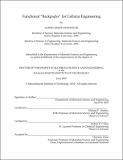Functional "backpacks" for cellular engineering
Author(s)
Swiston, Albert Joseph
DownloadFull printable version (51.58Mb)
Other Contributors
Massachusetts Institute of Technology. Dept. of Materials Science and Engineering.
Advisor
Michael F. Rubner and Robert E. Cohen.
Terms of use
Metadata
Show full item recordAbstract
Polymer multilayers may be built through the sequential ("layer-by-layer") adsorption of species (polymers, nanoparticles) with specific interactions (electrostatic, hydrogen-bonding). Multilayered heterostructures - films comprised of multiple lamellar regions or strata, each of which consisting of several bilayers of electrostatically complexed or hydrogen-bonded materials - may be assembled and patterned into precise geometries. These heterostructures maintain the functions and capabilities of each lamellar region, and thus complex, stimuli-responsive films with multiple functionalities may be fabricated and patterned with high fidelity. This thesis describes a method to fabricate such heterostructured devices for single-cell functionalization. These devices may be attached to the surface of living immune system cells, conferring new functions without impairing native cellular behaviors. The first part of this thesis focuses on the techniques to create a heterostructured backpack. Photolithographic methods were developed to geometrically pattern multilayer films into a desired size and shape. A host of polymer multilayer systems labile at physiologically relevant pH's were built and tested as a way to release the backpack from its fabrication substrate. Therapeutically and diagnostically interesting materials, such as magnetic nanoparticles, biodegradable polymers, and quantum dots were built into the backpack's payload region. Finally, a film that non-cytotoxically adheres the backpack to the cell surface was developed and optimized as the celladhesive region. How backpack attachment affect native cell behavior is of utmost importance. Backpack attachment was found to be non-cytotoxic to B lymphocytes, and T cells were still able to migrate on ICAM-coated surfaces. Backpacks could be made with specific chemistries that could activate desirable cell behavior, such as activating dendritic cells, which demonstrates that backpacks need not be passive objects but rather actively engage with the attached cell to create hybrid bio-synthetic devices. The last part of this thesis describes how backpacks can be used as functional phagocytosis-resistant particles that may be used to increase in vivo circulation time or functionalize phagocytic cells. This presents exciting opportunities for immunoengineering applications, such as using immune cells to invade solid tumors and deliver cytotoxic payloads.
Description
Thesis (Ph. D.)--Massachusetts Institute of Technology, Dept. of Materials Science and Engineering, 2010. This electronic version was submitted by the student author. The certified thesis is available in the Institute Archives and Special Collections. Cataloged from student submitted PDF version of thesis. Includes bibliographical references.
Date issued
2010Department
Massachusetts Institute of Technology. Department of Materials Science and EngineeringPublisher
Massachusetts Institute of Technology
Keywords
Materials Science and Engineering.